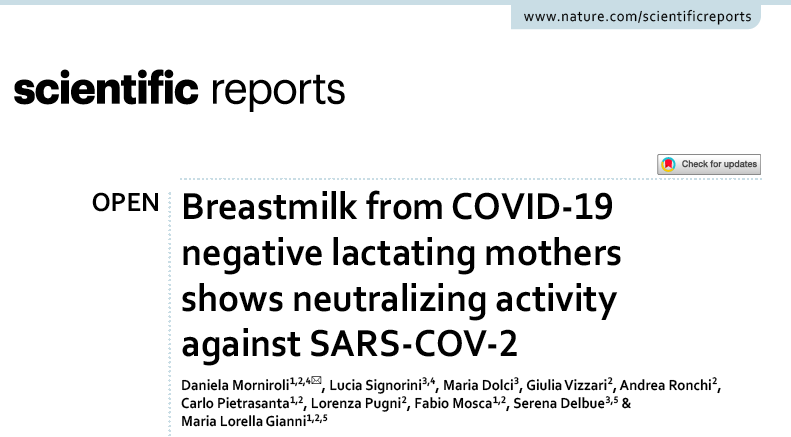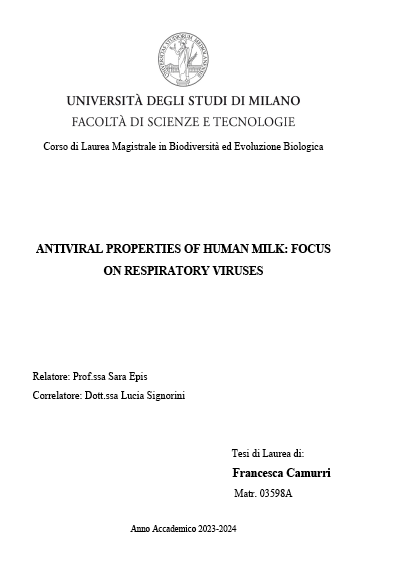
VIROLOGIA PERINATALE
ALLATTAMENTO E INFEZIONE DA SARS-CoV-2
PROGETTO DI TESI LAUREA MAGISTRALE
a cura di Francesca M. Camurri
Lo studio delle proprietà antivirali del latte materno si è intensificato con la pandemia da SARS Cov 2. Ricerche precedenti a quella attualmente in corso, hanno dimostrato la capacità del latte materno di inibire infezioni virali, sia in modo specifico cioè per la presenza di specifici anticorpi, che in modo aspecifico, cioè in assenza di specifici anticorpi ma grazie all'azione di altre molecole contenute nel latte. La ricerca sta continuando considerando altri virus respiratori oltre a SARS Cov 2: virus Influenza, Adenovirus. Il test di neutralizzazione, gold standard in microbiologia, permette di verificare la capacità di un campione biologico, in questo caso il latte materno, di inibire l'infezione virale di cellule suscettibili e permissive. Attraverso l'applicazione di una formula matematica, dai risultati del test di neutralizzazione ottenuti, si ricava il titolo neutralizzante, ovvero la diluizione del latte materno alla quale si ha il 50% di inibizione della replicazione virale. Per virus diversi, si utilizzano linee cellulari diverse. La ricerca si è concentrata anche sul test in vitro delle capacità di oligosaccaridi biosintetizzati strutturalmente identici a quelli contenuti nel latte, di agire come farmaco antivirale, per verificare in modo più approfondito il loro effetto.
ANTIVIRAL PROPERTIES OF HUMAN MILK. FOCUS ON RESPIRATORY VIRUSES
by FRANCESCA CAMURRI
Background: Human milk, source of antimicrobial defense for infants, is crucial for the short and long term health and has already demonstrated antiviral activity, due to its matrix of bioactive factors, comprising nonspecific antiviral components and specific antibodies. In particular, human milk confers protection against respiratory infections, drastically reducing morbidity and mortality in newborns, but its live virus neutralizing capacity has been rarely explored in vitro. Aim: The aim of the study was to determine the neutralizing ability of both colostrum and mature human milk against severe acute respiratory syndrome coronavirus 2 (SARS-CoV-2) and human Adenovirus C.1 (HAdV), defining the role of the specific IgG, and the nonspecific molecules, such as the fatty acids and the human milk sialylated oligosaccharides (HMO). Materials and methods: Milk was collected from two cohorts of mothers, 38 women enrolled at Policlinico IRCCS Cà Granda Ospedale Maggiore Policlinico (POLI) and 36 women enrolled at IRCCS Materno Infantile “Burlo Garofolo” (TS), from 4 to 360 days postpartum. Mothers enrolled in TS were subjected to COVID-19 vaccination a mean of 40 days before the milk collection. Total IgA and SARS-CoV-2 IgG were quantified in the samples by means of ELISA test, while anti SARSCoV- 2 and anti HAdV neutralizing activity (NT50) was evaluated infecting permissive cell lines, Vero E6 and A549, respectively, using the TCID50 method. Fatty Acids composition of POLI milk group was defined by means of gas chromatography separation and analyses; HMO antiviral activity was tested in vitro, in Calu-3 infected cell model. Results: IgA were present in 100% of POLI colostrum, POLI mature milk, TS mature milk samples, with a median value of 950000 ng/mL (range 287860-950000 ng/mL, 245180-972050 ng/mL, 271990-998930 ng/mL, respectively). Anti-SARS-CoV-2 IgG were present in 66,6% of POLI colostrum samples, with a median value of 2425 ng/mL (range 1605,75-41451 ng/mL), in 65% of POLI mature milk samples, with a median value of 2063 ng/mL (range 1598,65-29767,45 ng/mL) and in 84.3% of TS mature milk with a median value of 6925 ng/mL (range 1821,75-60140 ng/mL), with a significant difference between POLI and TS mature milk samples (p=0,004). The SARS-CoV- 2 median NT50 values were as follows: 1:5,42 (range 5,19-41,50) in POLI colostrum samples, 1:2,83 (range 2,24-20,75) in POLI mature milk samples, 1:0 (range 2-19) in TS milk samples. A significant difference was found between median SARS-CoV-2 NT50 value of POLI Colostrum and TS Milk groups (p=0,047). No neutralizing activity against HAdV was observed. A strong positive correlation (0,62) between TS milk samples-NT50 titers and Anti SARS-CoV-2 IgG, was found. A moderate positive correlation (0,36- 0,30) between SARS-CoV-2 NT50 and both Nervonic and Lignoceric FAs was found, while for Palmitoleic acid a moderate negative correlation was found. HMO showed an increasing antiviral activity (20-50%) when used at the concentration 0.002-0.125 ng/mL. Conclusions: Human milk showed different behaviors against SARS-CoV-2 and HAdV, probably due to the characteristics of the enveloped and naked virions. Although specific anti-SARS-CoV-2 IgG have been observed in almost all the collected samples, their presence significantly correlates with neutralizing activity only in mother subjected to recent vaccination: nonspecific neutralizing activity was probably due to other milk components, such as Nervonic and Lignoceric FAs. Given also the moderate antiviral activity of HMO observed in vitro, it is likely that the synergistic effect of all the components of the complex human milk matrix is essential, in order to increase as much as possible the protection of the infants against the respiratory viral infections.
I

